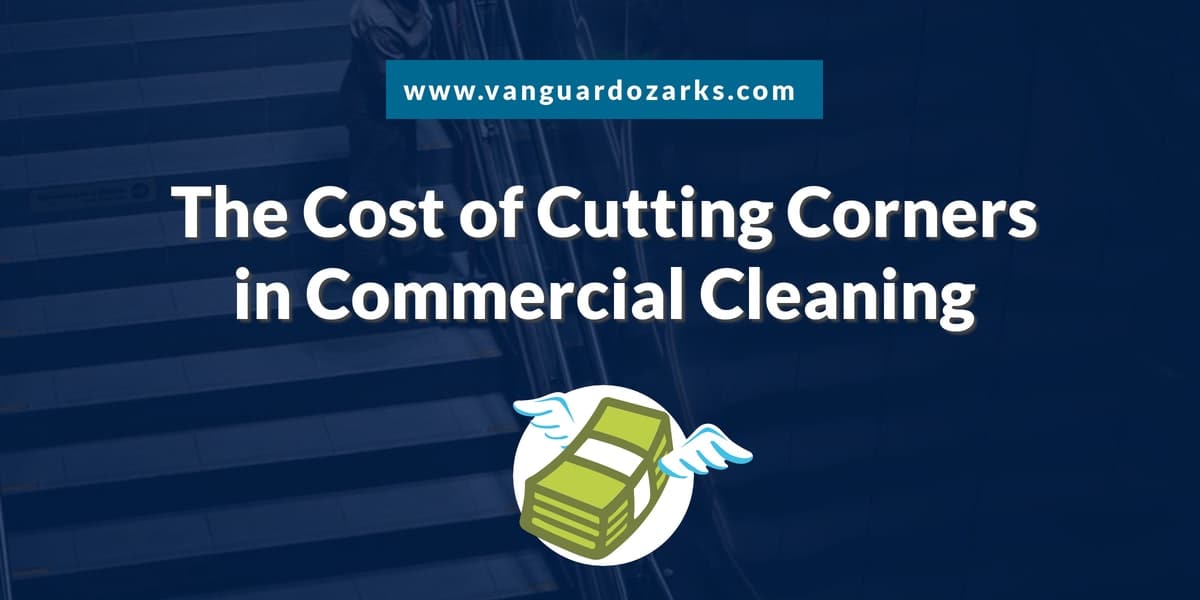Cutting corners in commercial cleaning services is an all-too-common issue that will negatively impact your organization's appearance, performance, and profits.
The Problem With Cutting Corners
Due to the somewhat intrusive nature of commercial cleaning processes, custodians often operate at night under minimal supervision.
When combined with the incredibly high industry turnover rates that plague janitorial businesses and in-house cleaning staff, the lack of supervision, experience, and training often leads to intentional or unintentional corner cutting.
The issue with this practice is that, eventually, a problem will arise that will strain relations with customers, hamper worker productivity, and likely lead to a host of costly health problems among building occupants.
Fortunately, there are several cost-effective solutions that will address these challenges while improving the health, safety, and functionality of your facility.
Commonly Cut Corners
There are several problem areas that are often missed during routine cleaning, including:
- Windows, specifically dust buildup around the edges, and blinds.
- Doors, especially around kickplates and handles, which are well-documented germ hot spots.
- Floors, typically under desks and along the edges where dirt and other material can build up over time.
- Desks, computer equipment, and phones, especially if the desktop is regularly cluttered.
- Bathrooms, most commonly behind toilets.
- Walls, which can be challenging to clean without streaking, especially in occupied workspaces.
- Trashcans, which should be scrubbed out regularly to remove bacteria and the source of foul odors.
- Lighting fixtures, both indoor and out, can quickly become covered in dust and bugs.
Issues That Can Arise From Cutting Corners
The most significant concern arising from cutting corners while cleaning is directly related to the health of the facility and individuals occupying the building, including customers, most commonly in the form of cross-contamination.
These issues can arise from:
- Poorly maintained equipment which can house and spread germs and bacteria, and;
- Poorly thought out cleaning practices that do not regulate foot traffic across recently disinfected areas or the material that is used to clean specific surfaces.
Additional challenges include:
- An increasing number of complaints from staff or customers, as well as;
- A decrease in occupant performance and business profits.
Outsourcing as a Solution to Cleaning Performance Challenges
Outsourcing your facilities cleaning services, or any business service is often the topic of critical debate.
On the one side, there exist legitimate concerns regarding the amount of control your school or business can maintain over the cleaning process.
Other issues concern potential communication and security challenges.
On the other side of the conversation, your organization can benefit in several ways, including reduced cost and management overhead, specifically in the realm of supervision, human resources, and training.
The real challenge comes from finding a happy middle ground where management is involved as much as they feel necessary while freeing up the organization to focus on mission-critical tasks, trusting in the professional partnership with outsourced service providers subject to security background checks and financially vested in the satisfactory delivery of the service.
All of these relevant points can be quickly addressed through upfront and ongoing communication between the management of the facility being cleaned and the custodial team and account managers.
Methods for Addressing Corner Cutting In House
Outsourcing is certainly not the only solution, and the challenges regarding corner cutting can be resolved internally but will require significant time and financial investment.
- Ongoing Traning - Maintaining a regular training cycle that involves all key personnel and decision makers, as well as the occupants the services affect, will ensure that everyone knows precisely what is expected of them throughout the entire service process.
- Financial Incentives - One of the biggest challenges facing in-house custodians are the historically low wages combined with little to no potential for advancement. This issue drives down the motivation to excel or remain at an organization for an extended period, costing businesses thousands of dollars per new hire in recruitment and training, as well as lost productivity while the new custodian is trained up to speed.
- Communication - A lack of efficient and bi-directional lines of communication is a fundamental challenge for nearly every aspect of any business. Since custodians typically work at night, maintaining a regular flow of information back and forth is crucial to meeting the needs of the building occupants the cleaning staff serves, whiling ensuring the communication sent their way extends beyond occupant complaints.
Takeaway
Though cliched; cleaning is a dirty job--often thankless, requiring long hours late at night, and not always in the most ideal conditions.
The single most important qualifier for ensuring a successful cleaning program is motivation--how are your teams motivated to clean at a superior level, ensuring the maximum output and satisfaction from all facility occupants.
Too often, those answers fall well outside of the budget of many organizations, and corners are cut, and people get sick, and reputations are lost alongside financial investments.
There is a better way.
Contact us today and discover why Vanguard Cleaning Systems® is the Standard of Clean® for businesses throughout Northwest Arkansas, Missouri, and Oklahoma.
In Oklahoma, dial 918-960-4450
In Arkansas, dial 479-717-2410
In Missouri, dial 417-812-9777


